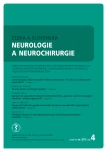The Oswestry Questionnaire, Version 2.1a – Results in Patients with Lumbar Spinal Stenosis, Comparison with the Previous Version of the Questionnaire
Authors:
B. Mičánková Adamová1ihash2 ,2 ,2; L. Dušek 3
Authors‘ workplace:
Neurologická klinika LF MU a FN Brno
1; CEITEC – Středoevropský technologický institut, MU, Brno
2; Institut biostatistiky a analýz, MU, Brno
3
Published in:
Cesk Slov Neurol N 2012; 75/108(4): 460-467
Category:
Original Paper
Overview
Introduction:
The Oswestry questionnaire (The Oswestry Disability Index, ODI) evaluates the impact low back pain has on activities of daily living through low back pain, quantifies patients’ subjective complaints and measures the level of disability. Even though multiple versions of the ODI are available, the authors now recommend version 2.1a that has also recently became available in the Czech language. The aim of this study was to emphasise that the new Czech version of ODI is available and to evaluate its correlation with the former Czech version (ODI 1.0) as well as to assess application of the ODI in patients with LSS.
Methods:
Both versions of the ODI (1.0 and 2.1a) were used for evaluation of 69 patients with lumbar spinal stenosis (LSS group) and 63 age and gender matched healthy volunteers (control group). The existence of any differences between both versions was evaluated in general and also with respect to age and gender. The results of the ODI 2.1a were analysed in detail in both groups.
Results:
Median ODI was 40% in LSS group and 0% in controls. No statistically significant differences were found between the two ODI versions neither in the cohort of LSS patients, nor in healthy controls within any of the age subgroups. Correlation analysis proved a high degree of correlation between both versions (r >0.98). Our findings thus proved that both versions of the ODI questionnaire are fully compatible and mutually interchangeable. The results of the ODI were significantly different between the LSS and control groups.
Conclusion :
The new Czech version of the ODI (2.1a) is fully interchangeable with the former version and should now be used to ensure consistency. We proved usefulness of the ODI in evaluating LSS patients.
Key words:
The Oswestry disability index – lumbar spinal stenosis – back pain – neurogenic claudication – pain assessment
Sources
1. Hägg O, Fritzell P, Nordwall A. The clinical importance of changes in outcome scores after treatment for chronic low back pain. Eur Spine J 2003; 12(1): 12– 20.
2. Fairbank JC, Couper J, Davies JB, O‘Brien JP. The Oswestry low back pain disability questionnaire. Physiotherapy 1980; 66(8): 271– 273.
3. Baker D, Pynsent P, Fairbank J. The Oswestry Disability Index revisited. In: Roland J, Jenner J (eds). Back pain: New Approaches to Rehabilitation and Education. Manchester, UK: Manchester University Press 1989: 174– 186.
4. Fairbank JC, Pynsent PB. The Oswestry Disability Index. Spine 2000; 25(22): 2940– 2953.
5. Roland M, Fairbank J. The Roland-Morris Disability Questionnaire and the Oswestry Disability Questionnaire. Spine 2000; 25(24): 3115– 3124.
6. Suarez- Almazor ME, Kendall C, Johnson JA, Skeith K, Vincent D. Use of health status measures in patients with low back pain in clinical settings. Comparison of specific, generic and preference‑based instruments. Rheumatology (Oxford) 2000; 39(7): 783– 790.
7. Taylor SJ, Taylor AE, Foy MA, Fogg AJ. Responsiveness of common outcome measures for patients with low back pain. Spine 1999; 24(17): 1805– 1812.
8. Adamova B, Vohanka S, Dusek L. A four year follow‑up of patients with lumbar spinal stenosis. Eur J Neurol 2005; 12 (Suppl 2): 154.
9. Fairbank JC. Use and abuse of Oswestry Disability Index. Spine 2007; 32(25): 2787– 2789.
10. Voháňka S, Mičánková Adamová B. Lumbální spinální stenóza a neurogenní klaudikace. Cesk Slov Neurol N 2009; 72/ 105(5): 405– 417.
11. Vohanka S, Adamova B, Dusek L. Clinical manifestations of lumbar spinal stenosis. Eur J Neurol 2005; 12 (Suppl 2): 154.
12. Vepřková P, Opavský J. Hodnocení bolesti a disability u pacientů s akutními a chronickými bolestmi dolní části zad. Bolest 2009; 12(4): 209– 214.
13. Opavský J. Vyšetřování osob s algickými syndromy a hodnocení bolesti. In: Rokyta R, Kršiak M, Kozák J (eds). Bolest. Praha: Tigis 2006: 172–179.
Labels
Paediatric neurology Neurosurgery NeurologyArticle was published in
Czech and Slovak Neurology and Neurosurgery

2012 Issue 4
- Memantine Eases Daily Life for Patients and Caregivers
- Metamizole vs. Tramadol in Postoperative Analgesia
- Metamizole at a Glance and in Practice – Effective Non-Opioid Analgesic for All Ages
- Memantine in Dementia Therapy – Current Findings and Possible Future Applications
- Advances in the Treatment of Myasthenia Gravis on the Horizon
Most read in this issue
- Cerebral Arachnoid Cysts in Adults – Retrospective Analysis of the Results of Surgical Treatment
- Rhythmic Movement Disorder
- Isolated Sphenoid Sinusitis – Possible Cause of Headache and Severe Complications
- The Oswestry Questionnaire, Version 2.1a – Results in Patients with Lumbar Spinal Stenosis, Comparison with the Previous Version of the Questionnaire
